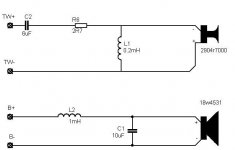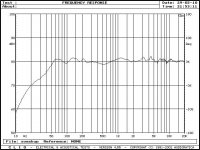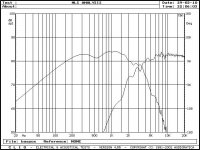No flames, but...
There is much more than "a certain amount" of theory/science involved as well as just getting to a starting point in order to arrive at a good-sounding speaker system. Listening and revising certainly will be required but it should be limited to "tweaking", not major changes. Very little actual experimentation should be necessary. True, the accuracy of software predictions is determined by the skill of the programmer and whatever assumptions he made, but you're apparently overlooking the many, many experiments and tests conducted by the software designer, in this case Martin King, to determine how the software should work and be able to accurately predict the actual outcome. One's ears have the final say, but one's mind wrapped around scientifically-based facts should get you to a final, high-performing design requiring very little if any subjective-based revisions before cutting that first piece of wood. The very fact that Tony's original design for the Optimo is apparently deficient proves the point, IMO.
There is much more than "a certain amount" of theory/science involved as well as just getting to a starting point in order to arrive at a good-sounding speaker system. Listening and revising certainly will be required but it should be limited to "tweaking", not major changes. Very little actual experimentation should be necessary. True, the accuracy of software predictions is determined by the skill of the programmer and whatever assumptions he made, but you're apparently overlooking the many, many experiments and tests conducted by the software designer, in this case Martin King, to determine how the software should work and be able to accurately predict the actual outcome. One's ears have the final say, but one's mind wrapped around scientifically-based facts should get you to a final, high-performing design requiring very little if any subjective-based revisions before cutting that first piece of wood. The very fact that Tony's original design for the Optimo is apparently deficient proves the point, IMO.
gfinlayson said:dublin78, a couple of questions:
Tony's selection of cabinet design for the Optimo was very empirical - based on actual measurement and listening tests rather than software predictions. I may get flamed for this, but what also has to be borne in mind is that software predictions are only as good as the programmer and the theoretical assumptions made in the software design.
With any aspect of speaker design, there's a certain amount of theory/science involved to get to the starting point, followed by a great deal of experimentation and subjective listening tests to arrive at the finished product.
"Tony's selection of cabinet design for the Optimo was very empirical - based on actual measurement and listening tests rather than software predictions. I may get flamed for this, but what also has to be borne in mind is that software predictions are only as good as the programmer and the theoretical assumptions made in the software design."
Very true, but TL software simulations nowadays are remarkably accurate, so the assumptions made and the mathematical models are very good indeed. I don't use Martin King's spreadsheets, I use Augsburger's program which has been shown to closely agree with Martin King's spreadsheets. In practice I have found that the computer simulations very closely follow the results I get when the speaker is built. So many people ignore this fact and go ahead and try and come up with something by trial and error, but are disappointed. Nowadays this approach is regarded as old fashoned becasue it wastes enormous amounts of time. IMHO nowadays it is just plain stupid not to use Martin's spreadsheets or Augsburger's program to design a TL speaker. What you see on the screen will be pretty much what you hear, and very little tweeking will be required so long as what you build is exactly what you simulate. If the simulations predict a lumpy response for the Optimo then that is almost certainly what you are hearing. I looked at Tony's Optimo, but it was obvious he did not do any computer simulations so it was very unlikely to get the best from the driver, so I did not persue it any further. Having done the simulations for that driver, I agree that it should work best in a MLTQWT, which unfortunately is not what you have built.
Very true, but TL software simulations nowadays are remarkably accurate, so the assumptions made and the mathematical models are very good indeed. I don't use Martin King's spreadsheets, I use Augsburger's program which has been shown to closely agree with Martin King's spreadsheets. In practice I have found that the computer simulations very closely follow the results I get when the speaker is built. So many people ignore this fact and go ahead and try and come up with something by trial and error, but are disappointed. Nowadays this approach is regarded as old fashoned becasue it wastes enormous amounts of time. IMHO nowadays it is just plain stupid not to use Martin's spreadsheets or Augsburger's program to design a TL speaker. What you see on the screen will be pretty much what you hear, and very little tweeking will be required so long as what you build is exactly what you simulate. If the simulations predict a lumpy response for the Optimo then that is almost certainly what you are hearing. I looked at Tony's Optimo, but it was obvious he did not do any computer simulations so it was very unlikely to get the best from the driver, so I did not persue it any further. Having done the simulations for that driver, I agree that it should work best in a MLTQWT, which unfortunately is not what you have built.
gfinlayson: Yes, I have checked and re-checked the XO. The reason that I was pinging ABO, was that I would like him to try my XOs in his cabinets if possible. Maybe I have done something mad?
Several members here have reported good things about the Optimos and love them, so I am struggling to understand why I am not feeling it.
The drivers are well run in now.
Several members here have reported good things about the Optimos and love them, so I am struggling to understand why I am not feeling it.
The drivers are well run in now.
My cabinet is shorter than the Optimo, the line length is about 1710 mm (67"), and it's heavily stuffed with BAF in the first half with a little in the second half. There is a slight dip at about 150 Hz, but I'm guessing it's minimised with the amount of stuffing I've got in place.
I've been thinking about how to finish my cabinets, and I've decided to paint them, with the drivers on a veneered panel. So as an experiment, I'm going to do as pkitt suggested and reverse the positions of the woofer and tweeter on a test panel and see how the FR and subjective listening are affected.
It'll be next week before I can try it out as I'm off to IoW tomorrow for the festival. I'll report back with my findings.
I've been thinking about how to finish my cabinets, and I've decided to paint them, with the drivers on a veneered panel. So as an experiment, I'm going to do as pkitt suggested and reverse the positions of the woofer and tweeter on a test panel and see how the FR and subjective listening are affected.
It'll be next week before I can try it out as I'm off to IoW tomorrow for the festival. I'll report back with my findings.
Is this shorter cabinet with a shorter line housing the SS8531? If so, your line length of 67" is pretty much optimum for an ML-TL for this driver. The 8531 performs very well in an ML-TL having a line length in the 55-65" range. The SS4531, however, needs a shorter line in an ML-Tl or a longer line in an ML-TQWT. In your cabinet, without modeling, the 8531 is likely to work really well when its center is located about 11-13" from the beginning of the line. If your 8531 is already located below the tweeter, swapping its position with the tweeter won't be a good idea because it would then be located too close to the beginning of the line.
gfinlayson said:My cabinet is shorter than the Optimo, the line length is about 1710 mm (67"), and it's heavily stuffed with BAF in the first half with a little in the second half. There is a slight dip at about 150 Hz, but I'm guessing it's minimised with the amount of stuffing I've got in place.
I've been thinking about how to finish my cabinets, and I've decided to paint them, with the drivers on a veneered panel. So as an experiment, I'm going to do as pkitt suggested and reverse the positions of the woofer and tweeter on a test panel and see how the FR and subjective listening are affected.
It'll be next week before I can try it out as I'm off to IoW tomorrow for the festival. I'll report back with my findings.
I have built a version of the Optimo for a friend using the 18w4531's and SB Acoustics ring tweeters. I did not use the parallel line, but a tapered one, because Tony mentioned a large peak (at 400hz, I think), but got more even FR with the tapered line. I did not use Tony Gee's suggested crossover network either, since I wanted to be able to tweak one driver's crossover without upsetting the other. I started off with 1st order x-over on both mid and tweat, crossing about 2400hz. I now have gone to 2nd order on the mid and 1st on the tweat and it sounds wonderful. There are some peaks and dips below 400hz when you measure it, but they are not very noticeableto the ear. I found stuffing quite densely with BAF for the 1st 1/3 of the tube and leaving the rest open to give good results. Sound-deadening material (rubber capet underlay) is placed on the side panels for about 3/4 of the tube length, and all along the front of the "separator" panel. Good quality caps are used - a mixture of PIO, Obbligato and ClarityCaps. Woofer impedance is equalised with a zobel network. The sound is absolutely stunning. It leaves my current Scanspeak system in the dust! Bass is not overly loud, but quite respectable. In free space, it is down about 6db from 400hz down, which should be compensated for perfectly with room-gain in most rooms. (I noticed Tony's pictures had his Optimos in corners!) Hope this helps. Regards, William.
Hello Vuki
Thank you for your post.
I will try this, although there are a few physical adjustments that I am going to make first. I have been extremely busy lately and have not been able to work on my Optimos.
Do you have any details of the inductors that you used (eg what were their measured resistances)?
Thank you for your post.
I will try this, although there are a few physical adjustments that I am going to make first. I have been extremely busy lately and have not been able to work on my Optimos.
Do you have any details of the inductors that you used (eg what were their measured resistances)?
- Status
- This old topic is closed. If you want to reopen this topic, contact a moderator using the "Report Post" button.
- Home
- Loudspeakers
- Multi-Way
- Humble Optimo TL stuffing tuning: Please help.


